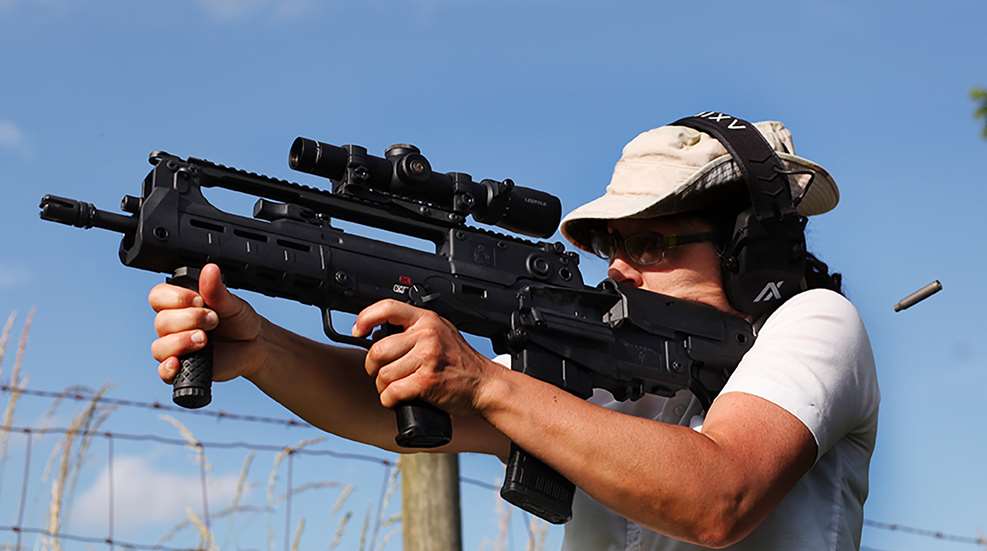
It was a failed shot thanks to a fogged-up scope on a hunting trip that drove Marcus Leupold, son of the founder of Leupold & Stevens, to enter the rifle scope market. Today the company is one of the leading optics manufacturers, producing everything from military-grade scopes to binoculars to performance eyewear.
 Earlier this year, Leupold & Stevens announced the introduction of the Patrol 6HD scope series. The Patrol 6HD 1-6X24 is a variable power rifle scope, meaning it can be used at 1x (no magnification) to 6x (six times magnification). This fact, along with the scope’s illuminated aiming point for low light conditions, allows it to adapt to a variety of uses, whether it be self-defense, competition or paired with your favorite hunting rifle. The linear field-of-view, or range of visible horizontal space when looking through the scope, measures approximately 120’ at the lowest power to 19’ when zoomed to the highest power at 100 yards. A wide field-of-view allows the scope to function like a non-magnified red dot sight at close range, while the scope’s magnification makes it easier to place precise shots at longer ranges, say the 200+ yard stages of a 3-gun match. Magnification can be changed quickly with the scope’s throw lever. The lever can be removed to leave a simpler, more traditional adjustment ring, if that is your preference. A compact and low-profile scope, the Patrol’s length comes in at 10.5”; it weighs about 16 oz. and has an objective lens that measures 24 mm.
Earlier this year, Leupold & Stevens announced the introduction of the Patrol 6HD scope series. The Patrol 6HD 1-6X24 is a variable power rifle scope, meaning it can be used at 1x (no magnification) to 6x (six times magnification). This fact, along with the scope’s illuminated aiming point for low light conditions, allows it to adapt to a variety of uses, whether it be self-defense, competition or paired with your favorite hunting rifle. The linear field-of-view, or range of visible horizontal space when looking through the scope, measures approximately 120’ at the lowest power to 19’ when zoomed to the highest power at 100 yards. A wide field-of-view allows the scope to function like a non-magnified red dot sight at close range, while the scope’s magnification makes it easier to place precise shots at longer ranges, say the 200+ yard stages of a 3-gun match. Magnification can be changed quickly with the scope’s throw lever. The lever can be removed to leave a simpler, more traditional adjustment ring, if that is your preference. A compact and low-profile scope, the Patrol’s length comes in at 10.5”; it weighs about 16 oz. and has an objective lens that measures 24 mm.
Leopold’s Patrol series is available with two reticle choices. The version I tested was the Duplex reticle system. Leupold introduced the now-familiar duplex reticle in the 1960s, when heavy lines tapered to thin crosshairs. These simple crosshairs are easy to see and quick to acquire. Patrol scopes use a second focal plane configuration, which means the reticle will appear the same size at any magnification.

In certain low-light conditions, it can become hard to see the black lines of a scope’s aiming point on the target. Leupold addresses this issue by offering an illuminated reticle on its Patrol scopes. On the duplex reticle, this is a simple center dot that Leupold calls the Firedot. The red Firedot aides in quickly finding the intersection of your crosshairs in low light. The illuminated reticle is turned on with a button on the left side of the scope and can be clicked through eight brightness settings, the brightest of which can be seen in the harshest daylight, while the lowest won’t blow out your night vision in low-light situations. In case you forget to turn it off, the scope will automatically turn off the illuminated reticle after five minutes of inactivity to preserve the battery. This is based on a motion-sensing technology that Leupold developed and will turn the illumination back on automatically once it detects movement. The other reticle option on the Patrol series is an illuminated CM-R2 reticle, which features bullet drop compensating aiming points out to 900 yards.

 To test out the Patrol, I mounted it on Springfield’s new Hellion bullpup rifle. Leupold supplied me with a set of medium height 30 mm Mark 4 scope rings, but due to the built-in backup sights integrated into the Hellion’s optics rail, I needed to use a riser so that the ocular lens would clear the sight release button. Depending on your rifle and its mounting system, Leupold offers a variety of different heights of rings and the provided chart will help you determine which mounting system you need for your scope and rifle combination. The steel Mark 4 rings fit Weaver/Picatinny rails. When mounting a scope, you want to make sure that it is level. To make this easy, the Patrol has an electronic reticle level. Secure your rifle in a vise, mount the scope, and then activate the leveling mode, which will tell you when the crosshairs are level to the rifle.
To test out the Patrol, I mounted it on Springfield’s new Hellion bullpup rifle. Leupold supplied me with a set of medium height 30 mm Mark 4 scope rings, but due to the built-in backup sights integrated into the Hellion’s optics rail, I needed to use a riser so that the ocular lens would clear the sight release button. Depending on your rifle and its mounting system, Leupold offers a variety of different heights of rings and the provided chart will help you determine which mounting system you need for your scope and rifle combination. The steel Mark 4 rings fit Weaver/Picatinny rails. When mounting a scope, you want to make sure that it is level. To make this easy, the Patrol has an electronic reticle level. Secure your rifle in a vise, mount the scope, and then activate the leveling mode, which will tell you when the crosshairs are level to the rifle.
 With the Patrol mounted on the Hellion, I zeroed the rifle at 100 yards with the scope zoomed to the highest power. The Patrol’s windage and elevation adjustment dials move your point-of-impact 1/4 minute of angle (MOA) with each click, or approximately ¼ inch at 100 yards. Need to move your group 2 inches to the right? Turn the windage dial eight clicks. Need to go down 5 inches? Give the elevation dial 20 clicks. Along with making an audible and tactile click, every mark and every two MOA of movement has a reference number. My first shots were about 10 inches high, so I dialed down the elevation by 40 clicks, which put my groups in the middle of the target. The windage was just slightly to the right so I adjusted the scope about an inch to the left. Learning how to zero a rifle scope can be tricky, but Melissa Bachman outlines the process in simple steps in this video.
With the Patrol mounted on the Hellion, I zeroed the rifle at 100 yards with the scope zoomed to the highest power. The Patrol’s windage and elevation adjustment dials move your point-of-impact 1/4 minute of angle (MOA) with each click, or approximately ¼ inch at 100 yards. Need to move your group 2 inches to the right? Turn the windage dial eight clicks. Need to go down 5 inches? Give the elevation dial 20 clicks. Along with making an audible and tactile click, every mark and every two MOA of movement has a reference number. My first shots were about 10 inches high, so I dialed down the elevation by 40 clicks, which put my groups in the middle of the target. The windage was just slightly to the right so I adjusted the scope about an inch to the left. Learning how to zero a rifle scope can be tricky, but Melissa Bachman outlines the process in simple steps in this video.
Once you have the rifle sighted in, you can re-zero the Patrol’s windage and elevation dials by firmly pulling up on the dial until it pops up. Then it will spin freely so that you can re-align the zero with the indicator mark. This feature allows you to adjust your scope in the field to compensate for distance or windage and then quickly return it to the original zero by turning back the dial.
 Moving off the bench, I wanted to see the capabilities of the Patrol at self-defense ranges 25 yards and closer. At these distances, the Patrol’s 1x setting makes it easy to quickly find your crosshairs and yields the maximum visibility of the target and its surroundings. I set up a series of drills where, on command, I brought the rifle up from a low-ready position and used the illuminated dot in the crosshairs to see how quickly I could acquire the target and place an accurate shot. My hits all stayed in the center-mass area and I could pull off a shot in about one second. I was shooting in the harsh afternoon sun angled slightly in front of me, but with the bright Firedot and the Patrol’s glare reduction capabilities, the target remained clearly visible.
Moving off the bench, I wanted to see the capabilities of the Patrol at self-defense ranges 25 yards and closer. At these distances, the Patrol’s 1x setting makes it easy to quickly find your crosshairs and yields the maximum visibility of the target and its surroundings. I set up a series of drills where, on command, I brought the rifle up from a low-ready position and used the illuminated dot in the crosshairs to see how quickly I could acquire the target and place an accurate shot. My hits all stayed in the center-mass area and I could pull off a shot in about one second. I was shooting in the harsh afternoon sun angled slightly in front of me, but with the bright Firedot and the Patrol’s glare reduction capabilities, the target remained clearly visible.
While the Patrol can quickly switch from a close-range to an extended range optic, it needs to be zeroed at the distance you expect to use it. With my rifle zeroed at 100 yards, my bullets impacted low when shooting from 25 yards. However, I was able to quickly adjust the scope and then easily switched back to my 100-yard zero when I moved back to that range.
While I didn’t throw the scope in a bucket of water or leave it in the freezer overnight, Leupold puts all of its designs through rigorous tests involving extreme temperatures, water submersion, violent impacts and elevation changes to ensure its products withstand the conditions of any environment so that “the internals of the optics stay moisture free and crystal clear for life.”

Low Power Variable Optics (LPVOs), like the Leupold Patrol, are some of the most versatile telescopic sights on the market. It’s good for the range because you can quickly zoom in and out to targets of varying distances for precise shots off a bench. I even had some novice shooters take on a line-up of fun balloons targets. They popped every one, demonstrating that the illuminated duplex reticle is easy to learn for all levels of experience. Want something for competition? The Patrol’s low-profile and light weight allows you to move quickly and acquire targets fast. Need a variable power hunting scope for your closer-range hunts? The Patrol is a rugged system for hunting in all types of conditions.
As fellow NRA Women contributor Heidi Lyn Rao explains in her article about Understanding Riflescope Basics, a quality scope is just as important as a quality rifle. The Patrol 6HD retails for $1,399.99 and is backed by Leupold’s lifetime guarantee. Just as Marcus Leupold attested to building a better scope, the family company continues to live up its reputation as being a pioneer in optics platforms.















































